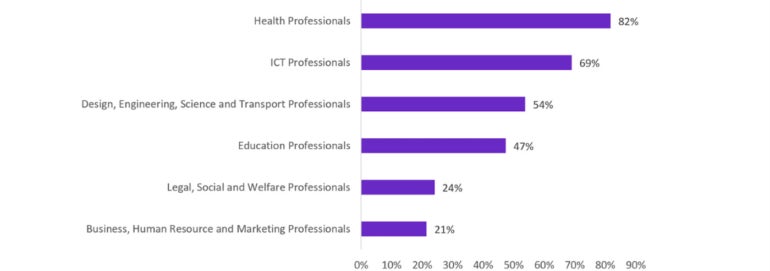Traditionally, companies and government organisations have attacked the challenges presented by IT individually. This has made sense, given that organisations that are successful at doing so then have a competitive advantage over others.
But with the public sector being encouraged to embrace a collaborative spirit and necessity pushing the private sector into collaborative projects, there seems to be an acknowledgement that most companies simply lack the resources to “go it alone” in many cases. Ultimately, a more collaborative approach to IT between departments and organisations might be the solution to many of the challenges facing Australian organisations, across both public and private sectors.
Jump to:
- The skills crisis is deepening
- Collaboration allows departments to address challenges together
- Using cross-collaboration to de-silo public and private sectors
- IT service providers will need to prepare for the shift
- The impact of cross-collaboration on IT workers
The skills crisis is deepening
There are many areas in IT where skills are in severe shortage in Australia. Recent reports show that nearly 70% of Australian IT jobs are now in shortage (Figure A). This applies across all areas of IT, including support, data science, security and software engineering.
Figure A

This almost unprecedented skills crisis hasn’t been seen in more than 60 years, according to the report, and many organisations are now failing to meet business objectives because they lack the talent necessary to achieve those objectives.
SEE: Logicalis employs talent as a service to combat the Australian skills shortage.
In areas where this is most critical, we’re starting to see organisations band together out of necessity to solve technology challenges, and these efforts are finding support within the government.
In one recent groundbreaking decision, the Australian Competition and Consumer Commission allowed banks to share data to combat the escalating menace of scams syphoning billions from Australians. While the ACCC initially harboured concerns about data usage, the overwhelming scale and cost of scams forced a change of heart. The combined resources of the banks are now being harnessed to combat this threat, and the project is in full swing.
This then raises the question of where else collaboration might be the solution.
Collaboration allows departments to address challenges together
As a recent article in The Mandarin noted, “Government tends to be siloed, so agencies needing to communicate with one another fall back on a technology they have been using for 30 years, email. A technology that creates additional silos in everyone’s inbox.”
Traditionally, government agencies have indeed been kept distinct, with their own IT budgets that are expected to solve all their problems for themselves.
However, COVID-19 and the response to that demonstrated something within government agencies. Suddenly, they were communicating on tools like Slack, both internally and cross-department, and behaving very much like an agile startup might. There was an immediate sense of collaboration that was brought across all of the government.
Now, some are seeing the potential for that trend to start tackling some of our largest natural disaster threats: bushfires.
As noted in an article at Government News, over the course of history, when there has been collaboration in technical fields, a population tends to be better off. The Bureau of Meteorology, for example, has a 90% accuracy rating. Combining data on fuel burning and sensor data collected by other government agencies in the field could assist greatly in identifying and mitigating the risk of bushfires, far beyond what could be achieved with departments acting independently.
Using cross-collaboration to de-silo public and private sectors
For Australian government departments to be able to de-silo, there are five steps that will be critical to the success of the transformation. These steps are the same for private sector businesses when embarking on collaboration projects.
However, the public sector has traditionally been slower at embracing the potential for collaboration and is often running older and legacy systems, whereas the private sector has always been encouraged to modernise and innovate. For the public sector, collaboration will be a bigger project.
Foster a collaborative culture
The first step is to create a culture that values collaboration. This can be achieved by setting clear expectations about teamwork and communication and by rewarding collaborative behaviour. This might be difficult, given that departments will have their own teams, tools and ways of doing things that might not be standardised, so the agreement to collaborate needs to be firm across all departments and teams.
Implement collaborative tools
Teams need to adopt technology to facilitate collaboration. This could include shared databases, project management tools or communication platforms that allow for easy information sharing and cooperation.
Encourage cross-departmental projects
Rather than integrating systems for existing projects, a better approach would be to look for opportunities to bring together teams from different departments to work on joint projects. This not only promotes collaboration but also helps to build relationships and understanding between departments.
Regular communication
Regular meetings and updates between departments can help keep everyone on the same page and prevent misunderstandings or duplication of effort.
Leadership support
The leadership of agencies plays a crucial role in breaking down silos. They need to lead by example, showing their commitment to collaboration through their actions.
IT service providers will need to prepare for the shift
As challenging as the idea of collaboration might be for internal IT staff and teams, Australian IT service providers are going to need to gear up for some fundamental shifts in how they tender and work with agencies.
One key threat, for example, in fostering better collaboration will be standardisation, and as government agencies work to de-silo, the bespoke solutions they had previously relied on will need to be replaced by a best-of-breed approach. IT suppliers will need to be able to demonstrate the compatibility of the solutions being deployed with what other departments might need.
Additionally, the supplier might need to be able to work at a greater scope and be part of the collaborative process between government agencies. This might naturally favour the larger organisations in the IT channel, so smaller organisations that work closely with the government will need to explore how they can continue to service a more ambitious IT agenda.
The impact of cross-collaboration on IT workers
For IT workers, this shift towards a more collaborative approach will be both challenging and rewarding. On one hand, they would need to adapt to new technologies and systems. This might require upskilling or reskilling as the demand for skills like cybersecurity and cloud computing increases.
SEE: Australian businesses are pressured to optimise cloud strategies.
On the other hand, IT workers could find themselves at the forefront of this digital transformation. Their role could evolve from being mere support staff to becoming strategic partners, influencing departmental policies and processes. This could lead to greater job satisfaction and career progression opportunities.
Most critical of all, however, is that it’ll result in better outcomes for the Australian population. According to PwC research, only 22% of citizens believe the government is “exceeding” their expectations for digital services. Better collaboration and resource-sharing between departments are going to be critical for improving the way the government is able to interact with citizens on the new digital frontier.


